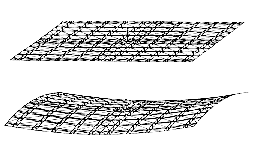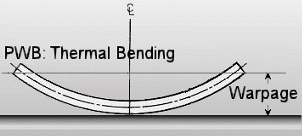Since the residual stresses which cause warpage are partly due to the
coefficient of thermal expansion (CTE) mismatch between the materials in
a PWB board, we may wish to search the reference
books for other composite structures which warp due to mismatched CTEs.
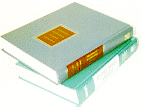
One such structure is a bimaterial beam bending due to a uniform increase
in temperature. Hence, we may wish to use this formula for a first order
analysis of PWB Warpage.
In fact, if the analysis variables are selected correctly, it turns
out that this simple model captures the maximum warpage wherever it occurs on the PWB! (For further details, examine our
Analysis Model Explanation page.) For example,
to model the board Yeh et al. analyzed
with FEM (illustrated at the top of the page) the figures for the 'input'
variables are:
Undeformed (i.e. initial) Length L = 276 mm
Undeformed Thickness t = 1.08 mm
Temperature Change  =
70 ºC (from 25º to 95ºC)
=
70 ºC (from 25º to 95ºC)
Specific Coefficient of Thermal Bending  =
1.10x10-7/ºC (from 25º to 95ºC)
=
1.10x10-7/ºC (from 25º to 95ºC)
Since the formula does not predict the direction of the warpage, the
resultant warpage figure (approximately 0.58 mm) represents the following
PWB configurations: (warpage greatly exagerated for clarity)
|
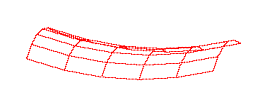
|
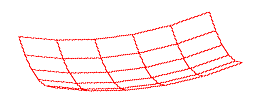
|
|
Saddle Deformation
|
Bowl Deformation
|
This first order analysis example illustrates how an analysis model
(which we call the thermal bending model) can be associated with a product (the PWB) to produce useful tool for designers and analysts.
This utility of associativity between a product model and an analysis
model is one of the fundamental concepts behind Product-Based Analytic
Models (PBAMs). We have therefore implemented this Thermal Bending Analysis
as a PBAM based tool for evaluating PWB Thermal Warpage. The following
pages provide further details of both the analysis model and the implementation
details. We hope that these pages will provide you with both an introduction
to the utility of PBAM-based tools, and a thorough exposition of the Thermal
Bending Analysis Tool.
To learn more about Thermal Bending Analysis, click here.
To see some of the specifications and implementation details of:
- The PWB Product Model, click here.
- The Thermal Bending ABB, click here.
- The PWB Thermal Bending PBAM, click here.
To view our reference sources, click here.
To begin analysis with this and other analysis models, first upload your STEP AP210 data
file on our Data Upload Page.
Link back to Tiger Home
Page at Tech.
